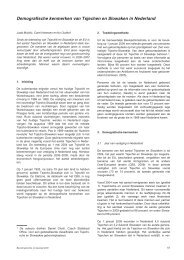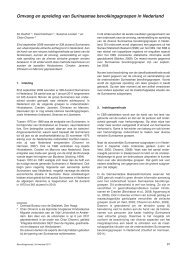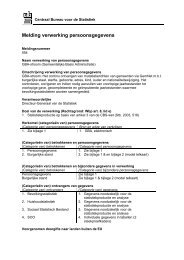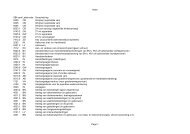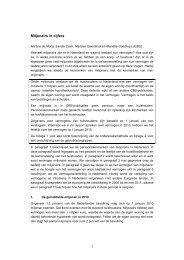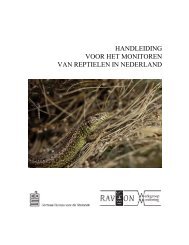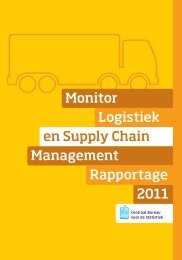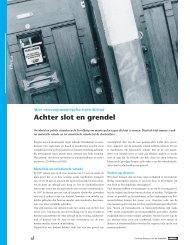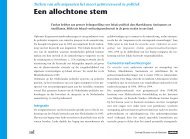Methoden voor de berekening van de emissies door mobiele ... - CBS
Methoden voor de berekening van de emissies door mobiele ... - CBS
Methoden voor de berekening van de emissies door mobiele ... - CBS
You also want an ePaper? Increase the reach of your titles
YUMPU automatically turns print PDFs into web optimized ePapers that Google loves.
2.4 Calculation methods<br />
2.4.1 Actual and NEC emissions<br />
Combustion of motor fuels: CO, NOx, VOC, particulate matter (PM10/PM2,5), SO2 and CO2<br />
Professional inland shipping<br />
The calculation of the emissions has been <strong>de</strong>veloped as part of Emissieregistratie en– Monitoring<br />
Scheepvaart 18 (EMS). This project has been implemented on behalf of the former Ministry of<br />
Transport, Public Works and Water Management, coordinated by DG for Public Works and Water<br />
Management, and executed by TNO among others. The emission calculation is based on the energy<br />
consumption per vessel class, which is <strong>de</strong>rived from vessel kilometres. For 28 vessel classes, the<br />
power <strong>de</strong>mand (kW) is calculated for the various inland waterway types and rivers. During this<br />
process, a distinction has been ma<strong>de</strong> between loa<strong>de</strong>d and unloa<strong>de</strong>d ships. In addition, the average<br />
travel speed of the various vessel classes in relation to the water, is ascertained <strong>de</strong>pending on the<br />
vessel class and the maximum speed allowed on the route that is travelled.<br />
The general formula for calculating emissions is the following:<br />
Emissions = Number . Power . Time . Emission factor<br />
The formula in the box below is used for calculating the emission of substance (s) in one direction (d)<br />
specifically for one vessel class (v,c), carrying a cargo or not (b), on every distinct route (r) on the<br />
Dutch inland waterways:<br />
Emissions from propulsion engines =<br />
the sum of vessel classes, cargo situations, routes and directions of:<br />
{number of vessel passages times<br />
average power used times<br />
average emission factor times<br />
length of route divi<strong>de</strong>d by speed}<br />
or<br />
E v,c,b,r,s,d = Nv,c,b,r,d . Pbv,b,r . Lr/(Vv,r,d + Vr) . EFv,s (1)<br />
Where:<br />
E v,c,b,r,s,d = Emission per vessel class, (kg)<br />
Nv,c,b,r,d = Number of vessels of this class on the route and with this cargo situation<br />
sailing in this direction<br />
Pbv,b,r = Average power of this vessel class on the route (kW)<br />
EFv,s = Average emission factor of the engines of this vessel class (kg/kWh)<br />
Lr = Length of the route (km)<br />
Vv,r = Average speed of the vessel in this class on this route (km/h)<br />
= Rate of flow of the water on this route (km/h), (can also be a negative value)<br />
Vr<br />
v,c,b,r,s,d = indices for vessel class, aggregated cargo capacity class, cargo situation,<br />
route, substance, and direction of travel, respectively<br />
The combination of the number of vessels, their power and their speed is the explanatory variable for<br />
emissions. The unit of the explanatory variable for emissions is "kWh". The emission factor is<br />
expressed in “kg/kWh”, the same unit that is used to express emission norms. The emission factors<br />
are <strong>de</strong>pen<strong>de</strong>nt on the engine’s year of construction.<br />
For calculating the above emission formula, a calculation mo<strong>de</strong>l has been <strong>de</strong>signed. This mo<strong>de</strong>l is<br />
managed by TNO. The calculation protocols and backgrounds of the EMS form the basis of the<br />
emission calculations [ref 100: Hulskotte, 2003]. The complete protocol (in Dutch) can be found on the<br />
website of the Dutch Emission Registration (download protocollen_scheepvaart.zip).<br />
18 Emission registration and monitoring of shipping<br />
43





